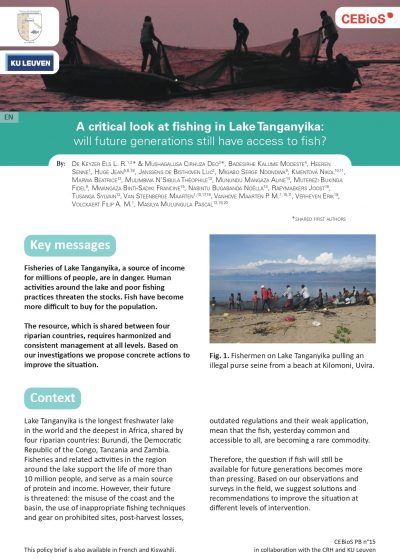VLIR-UOS VLADOC - Lake Tanganyika
Home » Partnerships » External projects » VLIR UOS VLADOC – Lake Tanganyika
Home » Partnerships » External projects » VLIR UOS VLADOC – Lake Tanganyika
VLIR-UOS VLADOC
Towards sustainable fisheries in Lake Tanganyika: integration of genetics, environmental data and stakeholder involvement (2016-2020, VLIR-UOS VLADOC)
Towards sustainable fisheries in Lake Tanganyika: integration of genetics, environmental data and stakeholder involvement (2016-2020, VLIR-UOS VLADOC)
This project concerns a VLADOC PhD scholarship awarded by VLIR-UOS to Els De Keyzer, with KU Leuven, RBINS and Centre de Recherche en Hydrobiologie (CRH) – Uvira (DRC) as partners. CEBioS was mainly involved in PhD student co-supervision, especially for the aspects related to field monitoring, capacity building and policy. CEBioS also contributed to the fish genetic aspects.
Context
Lake Tanganyika (LT) is the longest (650 km) and second deepest (1430 m) lake in the world. It provides livelihood and food security to millions of people. The fisheries of LT are extremely productive with an estimated annual catch of 200,000 tonnes feeding hundreds of thousands of people in the neighbouring countries: Burundi, DRC, Tanzania and Zambia. The main catch is composed of just three endemic pelagic fishes: two species of clupeid fishes (sardines): Stolothrissa tanganicae and Limnothrissa miodon, and a species of Nile perch: Lates stappersii.
There is a great uncertainty on the sustainability of the LT fisheries as this appears to be highly sensitive to climate change, decreased primary production and overfishing. The latter is considered, including by authorities in the neighbouring countries, a major threat to biodiversity and sustainable fisheries. Between 2002 and 2014, the number of fishers on the Lake has doubled because of an influx of refugees, while catch rates have declined steadily. Observations at landing sites show evidence of depletion of fish stocks. Although the two species of clupeids have dominated catches for a long time, large knowledge gaps remain regarding their biology and behaviour.
Improved knowledge is essential to avoid a mismatch between biological stock structure and management units. The lack of sufficient knowledge on the biology of the main fish species including genetic diversity and shoal movements (or migration) hinders the development of appropriate management strategies, vital for the future of the LT fishery. In DRC, the country with the longest LT shoreline, the national government mentions lack of knowledge, lack of correct quota, lack of stakeholder involvement and lack of specialists as reasons for uncontrolled and illegal fisheries.
Objectives
The overall objective was to improve applied biological knowledge of two key fish species of Lake Tanganyika, which provide more than 60% of the annual fish production (200,000 ton): the clupeids Stolothrissa tanganicae and Limnothrissa miodon commonly known as Lake Tanganyika sardines. The project aimed to increase knowledge of clupeid biology with an integrated, innovative and cost-effective strategy to monitor lake-wide and long-term trends in clupeid stocks with regard to the impact of climate change and overexploitation.
The specific objectives of the research were:
- To identify stock structure with phenotypic and genetic methods;
- To make use of knowledge from key informants, such as fishermen, scientists and policy makers (via semi-structured interviews).
Improved knowledge will allow to formulate specific management strategies for a sustainable pelagic fishery on Lake Tanganyika sardines.
Check out this Policy Brief, which is an output of the project:





